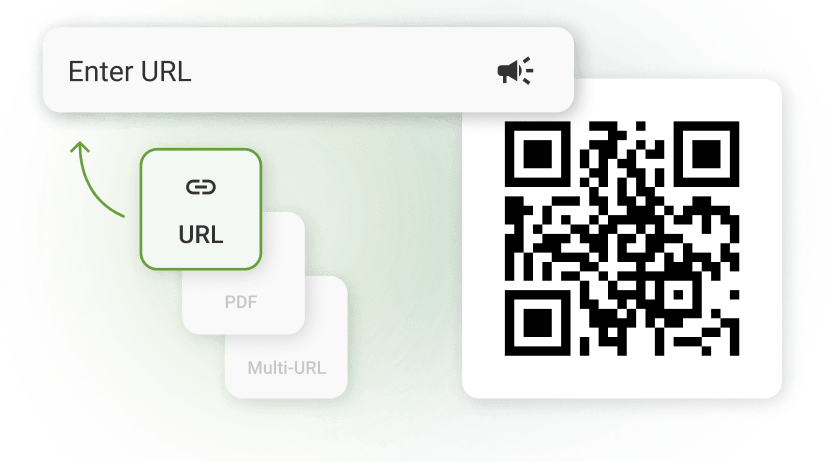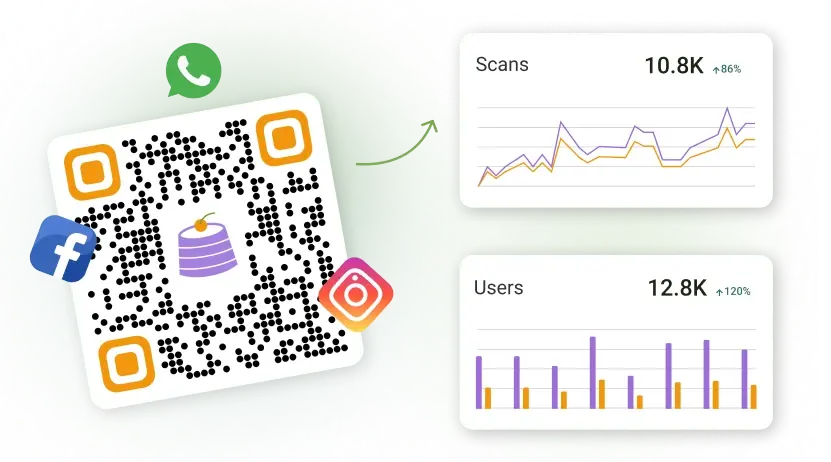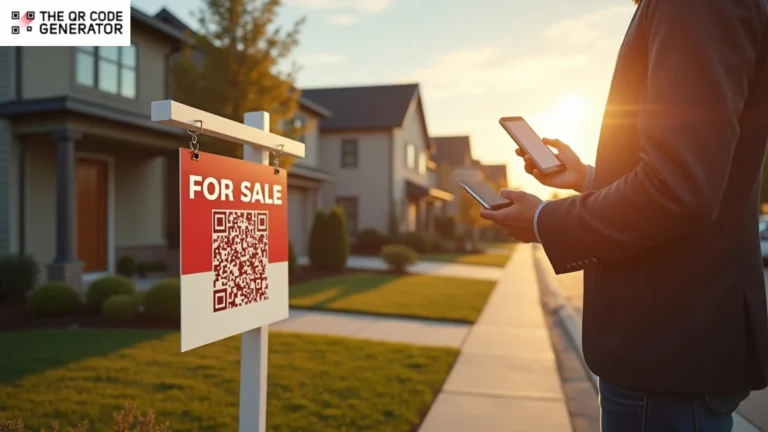When someone drives by your property, their first impression starts outside. A “For Sale” sign may catch their eye, but their curiosity fades fast if they cannot get more details right away. Depending on only phone numbers or brochures is outdated and slow in today’s fast-moving market.
There’s a more straightforward solution: adding a QR Code to your real estate sign. Buyers can scan it instantly and see property listings, take a virtual tour, or connect with you through a contact form on their phone.
This simple step transforms your yard sign from a static display into a smart lead-generation tool. To dive deeper, let’s first look at what actually slips through the cracks when a sign stands alone without a QR Code.
Table of contents
- What real estate agents miss with traditional for-sale signs
- How can QR Codes be used to generate more qualified leads in real estate?
- How to create QR Codes for real estate signs that buyers actually scan
- Best practices for creating real estate signs with QR Codes that convert
- Get the most out of your drive-by traffic
- Frequently asked questions
What real estate agents miss with traditional for-sale signs
Even the most eye-catching sign or billboard has limits. You might grab attention, but quickly lose momentum once buyers drive away. That is why static signs alone no longer cut it.
1. You cannot tell the full story from for-sale signs
A static panel cannot show off the upgraded kitchen, the fresh roof, or the dimensions of the lot. It leaves buyers curious but unsatisfied.
2. You miss silent leads who prefer to browse first
Not every buyer feels comfortable calling an agent right away. Many people want to look in private first. Without an easy digital option, you never even know these “silent leads” existed.
3. You lose lead capture when you are off-site
No agent can physically be present at every lawn sign, every hour of the day. That means countless curious drive-bys slip through unnoticed.
4. You get zero visibility into interest
Traditional signs might spark attention, but they never show you how much or from whom. You cannot measure demand or compare interest across listings.
5. You cannot prompt a next step at peak interest
A phone number on a sign asks for extra effort: pull over, dial, and start a conversation. Many won’t bother, even if they are interested.
6. You deal with inflexibility when listing details change
Every agent knows the frustration of reprinting signs when the price drops or the status changes. It is costly, slow, and wasteful.
In short, traditional signs grab attention, but they rarely convert it. For the shift to happen, you need to connect offline attention to online action in a way that feels natural for buyers.
How can QR Codes be used to generate more qualified leads in real estate?
Buyers who stop at the curb want answers immediately. The longer they wait, the faster their interest fades. That is where QR Codes step in. They fill every gap traditional signs leave behind, bridging curiosity and action, turning a simple sign into a lead generator that works day and night.
Let’s break down exactly how.
1. Give buyers a mobile-ready listing instantly
A scan should open a clean, fast-loading page with the essentials: price, photos, floor plans, and your contact button at the top. Mobile-first buyers do not have patience for endless scrolling or clutter. Keep it visual, short, and thumb-friendly.

Real-world example:
RE/MAX implemented QR Codes on yard signs and print ads. When scanned, buyers received instant mobile access to listings and agent contact details. This data lets RE/MAX target curbside browsers quickly, helping capture more qualified leads than static signs.
2. Turn curiosity into showings on the spot
When a buyer is parked outside and feeling excited, you want to capture that energy immediately. A QR Code that opens a scheduling tool or inquiry form lets them book a showing on the spot or send a quick question. This cuts out the dreaded phone tag and gives you warmer, higher-quality leads.
Real-world example:
A real estate agent from Integrity Core Realty used a QR Code sign-in for their app during open houses. This allowed visitors to instantly sign in, providing real contact details and streamlining data collection. Agents reported more efficient follow-up and higher qualification rates from QR Code-driven inquiries than slow, traditional methods.
3. Let buyers tour virtually before they commit
Sometimes, buyers do not want to book a showing until they know the property truly fits. Linking your sign QR Code to a 3D virtual tour or a short walkthrough video helps buyers self-qualify. Those who like what they see move forward faster, and those who do not will not waste your time with unnecessary appointments.
Real-world example:
ERA Real Estate implemented AR-enabled QR Codes that offer interactive virtual tours. Buyers can view the property, change wall colors, or rearrange furniture via their mobile devices. The company created an interactive experience and connected to various customers on different platforms.
4. Keep your sign relevant even after the sale
A static sign dies when the property sells. A dynamic QR Code keeps it alive. Update the destination to show nearby active listings or your personal portfolio. This way, you capture ongoing traffic from buyers still driving the neighborhood, instead of letting that attention drift away.
Real-world example:
Better Homes and Gardens used QR Codes integrated with CRM and beacon technology. After a property is sold, the QR Code signs continue to capture buyer attention, redirect prospects to active listings, and collect deeper data for future campaigns.
These use cases demonstrate the potential, but the execution often proves challenging for agents. A QR Code only works if you build it with the buyer’s experience in mind. That means thinking carefully about the flow from scan to action.
How to create QR Codes for real estate signs that buyers actually scan

You already know why QR Codes make real estate signs smarter. The next step is figuring out how to create them in a way that actually works in the field. Here’s a step-by-step flow to help you set them up the right way.
Step 1: Decide what you want the QR Code to do
Before you print anything, be clear about what you want from the scan. Do you want buyers to:
- View listing details?
- Book a showing?
- Sign up for alerts?
Pick one primary outcome so your landing page stays focused. If you try to do everything at once, you risk overwhelming buyers.
Step 2: Choose the right QR Code type
Static QR Codes work fine if your link never changes. In contrast, dynamic QR Codes let you update the destination, track scans, and reuse the code long term.

Most agents choose dynamic because listings evolve, prices drop, photos get updated, or statuses change. With dynamic, your sign stays valid without costly reprints.
Furthermore, remember to choose the right QR Code type for your goal. For example, you might use
- A simple URL to link directly to a property page
- A vCard QR Code to save your contact details instantly
- A multi-URL QR Code, if you want to show different links based on time or device
- A location QR Code to open the property address in Maps
Note: Platforms like The QR Code Generator(TQRCG) offer dynamic QR Codes that integrate with analytics, so you can measure engagement instead of guessing.
Step 3: Build the landing page buyers expect
The QR Code scan must lead to a page that feels smooth, quick, and made for mobile. Essentials include:
- Price and key details right at the top.
- A handful of clear, swipeable photos.
- One main action, such as “Book a showing” or “Save this listing.”
- An optional “Notify me” feature for alerts like price drops.
💡Pro tip: Keep forms short—name, email, maybe phone. That balance respects buyer privacy while still capturing leads.
Step 4: Generate and style your QR Code
Once you create your code, do not leave it as a plain black-and-white box. Add a frame or text that tells buyers what they get when they scan the QR Code, such as:
- “Scan for photos and price”
- “Tour this home now!”
Maintain a strong color contrast so the code scans easily. Avoid clutter; tiny logos or busy designs can reduce readability.
Note: Make your QR Code align with your brand colors so it resonates with your business. This creates brand visibility while making the code feel like a natural extension of your marketing materials.
Step 5: Place, test, and refine
The placement of your QR Code really matters. For a QR Code to work, buyers need to scan it from a safe, comfortable distance.
- Place it at eye level, not too low or too high.
- Leave at least 0.8 inches (2 cm) of clear space around the code.
- Ensure your QR Code size is large enough to scan from a parked car.
- Always include a short fallback URL just in case.
Once the sign is up, do a live test yourself. Scan from across the street, from the car, and from the sidewalk. Confirm that the landing page loads fast, as slow pages kill interest.
Then, track analytics. Look at when and where people scan. Based on what works, adjust placement, creative frames, or CTAs.
Real-world insight: QR Codes on real estate signs report better results when they tailor the scan message to the property or neighborhood. For example, “Scan to tour inside” works better at luxury homes, while “See nearby open houses” clicks with starter-home buyers.
Once you have the technical setup, the difference between a mediocre QR Code and a high-performing one comes down to strategy.
Best practices for creating real estate signs with QR Codes that convert
Slapping a QR Code on your “For Sale” sign won’t guarantee buyers will scan it. The QR Code design, placement, and how it’s connected make all the difference. With a few clever tweaks, your sign can go from being just another lawn fixture to a 24/7 lead generator.
Here are some best practices:

1. Brand every QR Code interaction
Every scan is an opportunity for buyers to remember you. Adding your logo, brand colors, or photo to the QR Code frame or landing page makes the experience feel personal.
Buyers begin to connect your name with convenience and professionalism. The more often they see your branded QR Codes, the more likely they will recognize you at another listing and think of you when they share referrals.
2. Capture leads right after the scan
Sharing information is helpful, but capturing leads is what grows your business. The smartest QR Code flows give buyers what they want while encouraging them to take a small step with you.
You might ask them to enter their email to unlock more photos, RSVP for an upcoming open house, start a quick chat with you, or save the listing directly to their phone. When you catch their attention in the moment, you turn curiosity into a real contact you can follow up with.
3. Create a neighborhood map when you have multiple listings
If you have several homes for sale in the same neighborhood, you can make one QR Code work harder. Link it to an interactive map that shows each property with pins, open house times, and even driving or walking directions between them.
This turns a casual drive-by buyer into someone who can tour multiple listings in one trip, which increases the chances they connect with one of your properties.
4. Use scan data to fine-tune your approach
With dynamic QR Codes, you can see exactly how buyers interact with your signs. You get details like what time of day people scan, which listings get the most attention, and what devices buyers use.

This information helps you make better decisions, whether adjusting where you place your signs, testing different call-to-action frames, or highlighting the features buyers care about most. Instead of guessing, you use real behavior to guide your strategy.
5. Highlight “what’s changed” in the property
Homes evolve quickly—price drops, fresh staging, or even new drone photos. Instead of just linking to a static listing, you can use the QR Code to spotlight what’s new since the last time someone looked.
Imagine a buyer who drove past a month ago. This time, your QR Code could show: “Now $15,000 less,” “Just staged: see the new living room look,” or “Updated backyard tour added today.” This makes repeat scans more meaningful and keeps your sign feeling alive instead of outdated.
A QR Code on a sign may feel like a small tweak, but it transforms how buyers experience your listings. For agents, that means fewer missed opportunities and more qualified leads landing directly in your pipeline.
Get the most out of your drive-by traffic
Now you know that instead of hoping for someone to remember to look up the listing later, you can give them an instant path to photos, tours, and even a direct line to you. QR Codes on real estate signs turn casual drive-bys into measurable leads you can follow up with.
Think of it this way: You already invest in photography, staging, and signage. Adding a QR Code is the lowest-effort upgrade that makes all those investments work harder. You gain insights into what buyers engage with, shorten the gap between curiosity and contact, and set yourself apart from agents who still rely only on static signs.
If you want your signs to stop working like billboards and start working like smart lead magnets, QR Codes are the next step. Ready to try it?
Create your QR Code with TQRCG here.
Frequently asked questions
A real estate QR Code should give buyers instant access to the essentials—property photos, pricing, and key features—along with your contact details. If you want to take it further, you can link to 3D tours, floor plans, or even a showing scheduler for a more engaging experience.
Yes, sign riders are an ideal place for QR Codes. You can use them for targeted CTAs like “Schedule a Tour” or “Watch Video Walkthrough,” giving buyers a clear next step without crowding your main for-sale sign.
Dynamic QR Codes make tracking easy by showing you scan numbers, devices, locations, and engagement patterns. This data helps you understand buyer behavior and refine your marketing strategy for future listings.
Absolutely. With many buyers searching on their phones, QR Codes bridge the gap between offline signs and online information. They save buyers time and keep your leads warm in the exact moment they feel curious.
Yes. Most smartphones today can scan QR Codes directly through the built-in camera, so buyers do not need to download a separate app. This makes scanning fast, effortless, and more likely to convert.







